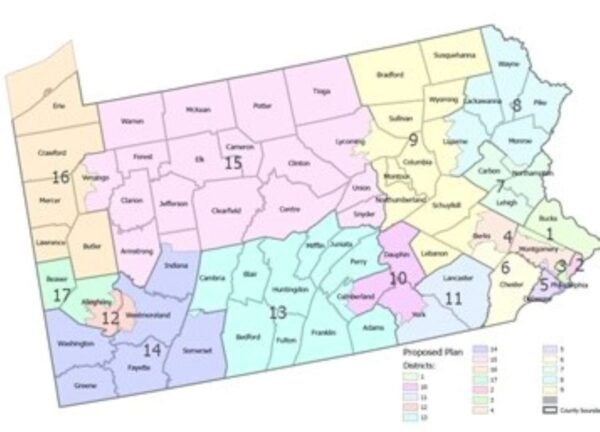
Pennsylvania Supreme Court Picks New Congressional District Map
By Beth Brelje
For the second time in a row, the Pennsylvania State Supreme Court has chosen a new Congressional district map instead of the General Assembly, which is tasked with the job.
For months, members of the General Assembly sought public input and worked to draw a new map. Republicans, who control Pennsylvania’s House and Senate, agreed to a new map in January, but Democratic Gov. Tom Wolf vetoed it.
Ultimately it ended up in the hands of the Democratic-controlled State Supreme Court, which picked the new map Wednesday in a 4-3 decision. Before the decision, a challenge to the legitimacy of the Supreme Court choosing the map was filed by Republicans in federal court, so it is still unclear if this new map will stick.
Congressional maps must be redrawn every 10 years after the census. Districts must have about the same number of people, but populations change. The 2020 census showed Pennsylvania was growing slower than other states, so Pennsylvania lost one district and after the midterm election, will only send 17 representatives to Washington.
In 2018, the League of Women Voters, with the support of Fair districts PA, challenged Pennsylvania’s congressional map, saying it was too gerrymandered to be fair. That map was not due to be redrawn until now, but, right before the 2018 primary election, the state Supreme Court drew its own map that changed the power in some districts.
And that is what makes congressional and state legislative maps so contentious. Unless the Supreme Court gets involved, the elected party in power has the most say in drawing the maps. The task is to draw the maps fairly, but sometimes counties, towns, and school districts get sliced into multiple districts, putting voters likely to vote for one party, with those who would vote the other way, diluting the power of their vote. Or shaping a district to increase members of one party, in an attempt to define the power of the district as Republican or Democratic.

The new 17-district map has one less Republican-leaning district and the same number of Democratic-leaning districts compared to the current 18-district map Pennsylvania is living under, data analysis from Project 538 shows. Pennsylvania is still solidly a battleground state, with eight republican leaning districts and six democratic leaning districts plus three highly competitive districts.
Pennsylvania’s Republican lawmakers are not happy with how this map got approved.
“This is not about where lines are drawn or where they could have been drawn. The court has now confirmed once and for all, they do not abide by the state and federal Constitutions,” Speaker of the House Bryan Cutler and House Majority Leader Kerry Benninghoff wrote in a joint statement.
“Only the map submitted by House and Senate Republicans followed all constitutional guidelines, went through a deliberative legislative process and was endorsed by a judicial body. The process for creating district lines is clearly defined, and even if the governor refused to follow the process, it does not allow the courts to just pick and choose when or when not to follow the law. Sadly, candidates and voters must now submit to a unilateral court that sees itself above every person in our Commonwealth.”
Republicans have argued that as elected officials, they represent the people directly and since the state constitution puts them in charge of drawing the map, it should not be taken out of their hands.
“Today’s decision by the court was shamefully partisan. In its ruling, the court said elected members of the General Assembly, who are tasked with ensuring the voices of Pennsylvanians are heard, don’t matter. Instead, the court said the National Democratic Redistricting Committee outweighs the voice of the people. The court justices who selected the map bowed to the wants and wishes of their Democratic National Committee handlers,” Rep. Seth Grove said in a statement.
He noted that the court ignored the recommendation of its own selected special master, Commonwealth Court Judge Patricia McCullough, a Republican, who was charged with endorsing a fair map. She recommended a citizen-drawn map, saying it met all the criteria of the Free and Equal Elections Clause.
“With the swipe of their pens, four Democrat justices from Pittsburgh and Philadelphia eviscerated the months of work the General Assembly and the citizens of Pennsylvania put into developing a fair and constitutional congressional map,” Grove said. “Obviously, the message was clear by the courts: it doesn’t matter what process the General Assembly or the people use, we care more about the opinions of partisan national groups.”
The National Democratic Redistricting Committee, chaired by former Obama administration attorney general Eric Holder, has aggressively worked to have a hand in redrawing maps around the United States.
The committee has a four-prong strategy to invest more money in areas it considers crucial for redistricting, including many smaller races such as mayoral races, where newer politicians sometimes cut their teeth.
Starting in 2018, it promoted rule changes in statehouses to change who gets to draw the maps.
The National Democratic Redistricting Committee works alongside affiliates, its website says, to take legal action against maps it deems unfair, and it has built “a massive grassroots campaign to prepare for the redistricting battles ahead because Republicans will fight hard to protect their manipulated system,” Holder explains in a video about the committee.

Democrats gerrymander, most of the Republican maps were pretty logical, they merely realigned some of more ridiculous features of the Democrat maps. Bring the ruling to SCOTUS and have it overturned—get governors and courts out of this process once and for all.